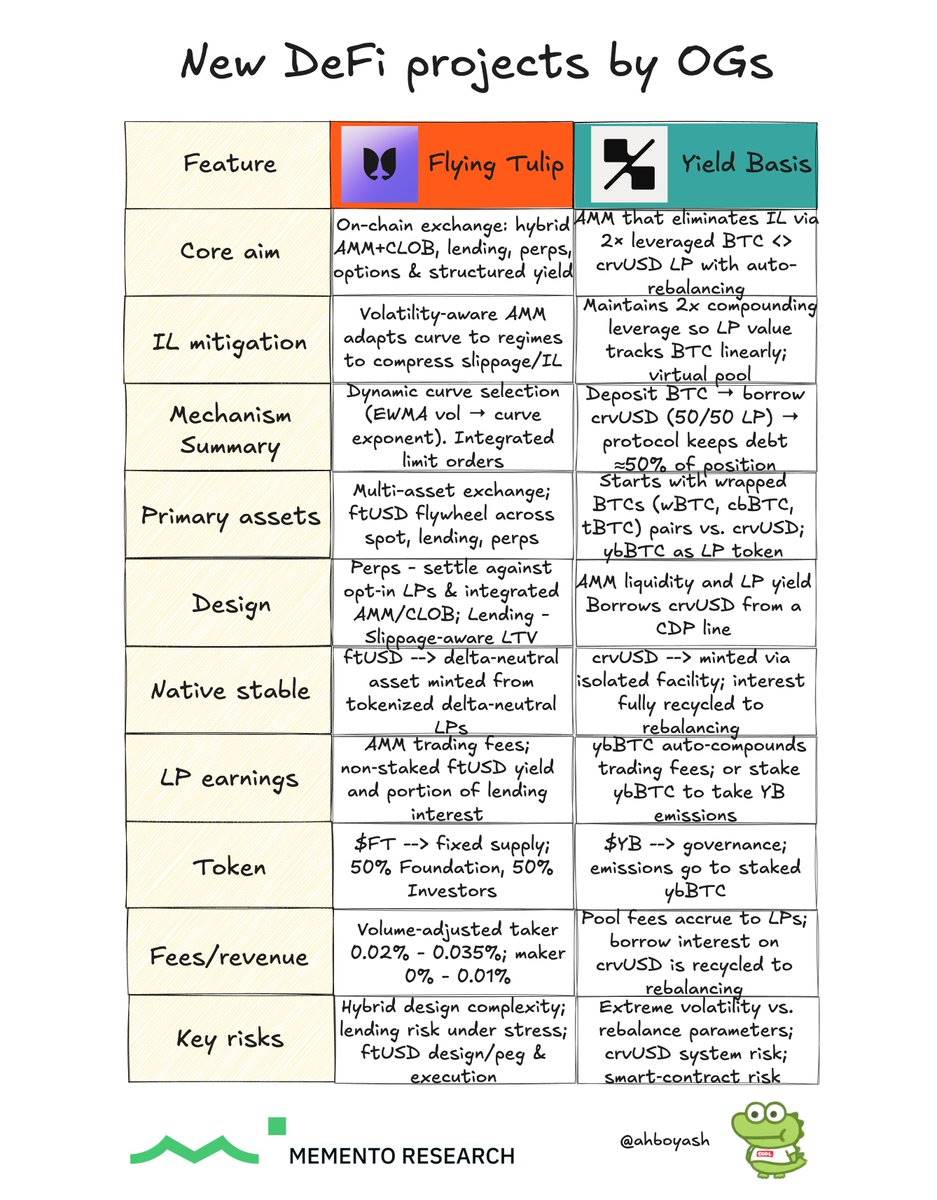A new king emerges in DeFi?
Curve founder launches Yield Basis to address BTC liquidity impermanent loss issues, while Yearn founder builds Flying Tulip, a unified AMM+CLOB exchange; both aim to optimize on-chain liquidity. Summary generated by Mars AI. This summary was generated by the Mars AI model, and its accuracy and completeness are still being iteratively improved.
The founder of Curve Finance, @newmichwill, is launching @yieldbasis, a bitcoin AMM liquidity platform with no impermanent loss (Note from Deep Tide: IL, impermanent loss, refers to the potential loss you may suffer as a liquidity provider to an AMM compared to simply holding those tokens);
Meanwhile, the founder of @yearnfi and DeFi god @AndreCronjeTech is building @flyingtulip_, a unified AMM+CLOB (Note from Deep Tide: Automated Market Maker + Central Limit Order Book, where AMM provides continuous liquidity and automatic pricing, and CLOB offers more precise price discovery and order execution) exchange.
Two different attempts to solve the same problem — how to make on-chain liquidity truly effective:
- Yield Basis ($YB): A Curve-native AMM that eliminates impermanent loss for BTC liquidity providers by holding a constant 2x leveraged BTC-crvUSD liquidity pool (the LP’s value remains 1:1 with BTC while earning trading fees). Users can mint ybBTC (yield-bearing BTC).
- Flying Tulip ($FT): An on-chain unified exchange (including spot, lending, perpetual contracts, options, and structured yield), based on a volatility-aware hybrid AMM+CLOB architecture, combined with a slippage-aware lending mechanism, and ftUSD (a delta-neutral USD equivalent) as the core incentive.
Yield Basis
- Traditional AMMs cause BTC liquidity providers to sell when the price rises or buy when the price falls (√p exposure, Note from Deep Tide: market risk exposure measured in units of the square root of price), resulting in impermanent loss that often exceeds the fees earned from providing liquidity.
- The specific mechanism of Yield Basis will be introduced in detail later, but the core is: users deposit BTC into the platform, the protocol borrows an equivalent amount of crvUSD, forming a 50/50 BTC-crvUSD Curve liquidity pool, and operates with 2x compound leverage.
- A re-leveraged AMM and virtual pool will keep the debt approximately equal to 50% of the liquidity pool value; arbitrageurs profit by maintaining constant leverage.
- This allows the value of the liquidity pool to change linearly with BTC, while also earning trading fees.
- Liquidity providers hold ybBTC, a yield-bearing BTC receipt token that automatically compounds trading fees denominated in BTC.
- The platform also offers a governance token $YB, which can be locked as veYB for voting (e.g., choosing liquidity pool reward allocations).
- Yield Basis mainly targets BTC holders who want to unlock productive BTC and earn fees in protocols that solve the impermanent loss problem.
Flying Tulip
- The user experience and risk settings of traditional decentralized exchanges (DEX) are usually static. Flying Tulip aims to bring centralized exchange (CEX)-level tools on-chain by adjusting the AMM curve according to volatility and adjusting the loan-to-value ratio (LTV) of lending based on actual execution/slippage.
- Its AMM adjusts curvature based on measured volatility (EWMA)—that is, it flattens (approaching constant sum) when volatility is low to compress slippage and impermanent loss; when volatility is high, it becomes more product-like to avoid liquidity exhaustion.
- ftUSD tokenizes delta-neutral liquidity pool positions and is used for incentive mechanisms and liquidity programs.
- The platform token $FT may be used for revenue buybacks, incentives, and liquidity programs.
- Flying Tulip is a DeFi super app: an exchange that supports spot, lending, perpetual contracts, and options simultaneously.
- Execution quality depends on accurate volatility/impact signals and robust risk control under stress conditions.
Outlook for Both Projects
Yield Basis aims to become the platform for BTC liquidity; while Flying Tulip is committed to becoming the platform for all on-chain native trading. In the current era where perpetual contract decentralized exchanges (Perp DEX) are mainstream, the launch of Flying Tulip is timely. Frankly, if it can deliver optimal execution, Flying Tulip could even channel future BTC flows into pools like YB.
If Yield Basis succeeds, ybBTC could become the “stETH” primitive for bitcoin: BTC exposure + LP trading fees, with no impermanent loss.
Flying Tulip has the potential to launch its integrated stack, giving users access to centralized exchange (CEX)-level tools; aiming for “one-stop trading, covering all of DeFi.”
While remaining cautiously optimistic about both projects, it should not be overlooked that these projects from veteran founders and top teams are still untested, and the founders also need to balance the development of other protocols (such as Curve and Sonic).

Disclaimer: The content of this article solely reflects the author's opinion and does not represent the platform in any capacity. This article is not intended to serve as a reference for making investment decisions.
You may also like
Telegram, the world's largest social platform, launches major update: Your graphics card can now mine TON
Telegram’s ambition for privacy-focused AI

A well-known crypto KOL is embroiled in a "fraudulent donation scandal," accused of forging Hong Kong fire donation receipts, sparking a public outcry.
Using charity for false publicity is not unprecedented in the history of public figures.

An overview of two new projects in the Polkadot ecosystem and what they will bring to Polkadot Hub

HIC: Continue to bring truly valuable new projects to Polkadot in a sluggish market!

